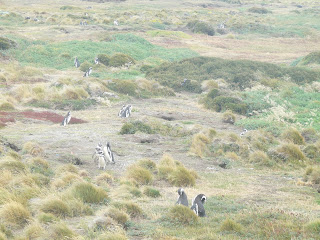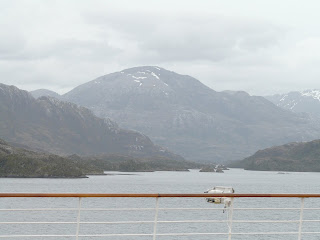Every evening a daily program for the following day is delivered to each cabin, or stateroom as they’re supposed to be called. Here is what tomorrow, January 24th, 2010, holds.
The program first offers a brief bio of Thomas Grindlay, the Dining Room Manager. We learn he’s from Canada, living near Huntsville, Ontario. He worked in the hospitality industry in Toronto, and then at the Banff Springs Hotel. Realizing he was bored with the hotel industry, he came to work for HollandAmerica as Maitre’d, “and the rest, as they say, is history. He supervises a staff of nearly 90 hard-working professionals who are dedicated to making sure you have the finest service on the high seas.”
There’s a paragraph from the navigator every day, telling us the bearing and planned course, although today it’s a discussion of how you can use your watch as a compass. If you hold your watch horizontally and point the hour hand toward the sun, south will be at a point approximately midway between the centre of 12 and the hour hand. I’m not sure, though, if this applies only in the southern hemisphere. Anyone know?
There’s a half-hour set aside for guest to have a photo taken with the Captain.
The dress code is formal, meaning for the ladies, gowns, cocktail dresses or elegant pantsuits, for the men, jacket and tie are required, dark suit or tuxedo suggested, cultural formal wear such as Asian style is also acceptable. It also says, “In order to compliment your fellow guests, please observe the dress code throughout the entire evening in the indoor bars, the La Fontaine dining room, and the Pinnacle Grill.” For those guests who don’t want to dress up, there’s the Lido restaurant, a cafeteria self-serve place.
Here is “Today at a Glance.”
7:30 a.m. Sit and Be Fit in the Queen’s Lounge
8:00 a.m. Catholic Mass Wajang Theatre
Walk a Mile Meet at Lifeboat 6 Deck 3
9:00 a.m. Tai Chi
Dance Class A: Cuban Mambo Crow’s Nest
Watercolour Class A
Protestant Sunday Worship
Daily Quiz Available, 9:00 – 3:00 (This includes a trivia sheet on a selected topic, plus a Sudoku puzzle, and maybe other things, I don’t know.)
Sports Equipment Available, 9:00 – 6:00 (Ping Pong, Paddle Tennis, Shuffleboard, Volleyball, Basketball, maybe more.)
9:30 a.m. Onboard Sports: Target Toss
Culinary Question and Answer (no topic listed, which is unusual)
Morning Coffee is served, 9:30 – 10:00 (I’m not sure why this is here, as you can get coffee any time you wish)
10:00 Seminar: One of a Kind: The Jewelled Creations of Sidney Mobell
Digital Workshop: Put Your Best Face Forward:Editing Your Cruise Photos
Beginner Bridge Lecture in the Hudson Room
Bridge Lecture in the Wajang Theatre
Fitness Class: Pathway to Yoga $12.00 in the Greenhouse Spa
Paddle Tennis Players meet
10:30 Wii Bowling
Favaro Collection Unveiling & Prize Giveaway in the Signature Shop (sells jewelry)
11:00 Explorations Speaker Series with John Palmisano (one of several speakers, I can’t remember if he’s the language expert or South American history, no topic listed)
Techspert Time with Jeff (he’s does workshops on photos, blogs, etc, and this is time to ask him questions or seek individual help)
Sidney Mobell book signing
Gems of South America in the Mirabella Luxury Boutique (the higher-priced jewelry store)
Spa Seminar: Burn Fat Fast (maybe I’ll go to this)
11:15 Fruit and Vegetable Carving
12 noon The ‘Brain’ Super Team Trivia (I do this, although the questions on this cruise are way more difficult than on others, but I guess we all need a reminder of how much we don’t know)
Singles and Solos meet for lunch (I’ve never been to one of these)
Blackjack Tournament in the Casino
Lunchtime Music on the Lido Deck
Voice from the Bridge Announcement (the Captain comes on, speaks about where we’re going, what weather we might expect, sometimes has maritime trivia or information)
1:00 Watercolour class B (some classes are popular enough, and in too small a space, so they do the class twice.
Art History at Sea
Opera Appreciation with Rabbi Mintz
Arthritis Relief with Acupuncture
1:30 Texas Hold ‘Em Tournament (all cruise ships I’ve been on have a casino)
2:00 Exploration Speaker Series with Ron Barasch
Creative Writing (that’s me!)
Digital Workshop: Your Away from Home Movie
Basketball players meet on the Sports Deck
Party Bridge (this is supposed to be like social bridge, non-competitive as compared to the Duplicate Bridge) in the Hudson room
Duplicate Bridge in the dining room
2:30 Arts & Crafts
Onboard sports: Hole-in-One Golf Challenge, in the Atrium
3:00 Dance Class B
Photography Lovers meet
3:15 – 4:00 Afternoon Tea
4:00 Bonus Card Snowball Jackpot Bingo (costs money)
Amsterdam Book Club meets (me again. In between I’ll have office hours, which is regular thing but is never in the program. It’s time for fledgeling critique groups and people who want one-on-one time with me)
Techspert Time with Jeff
Friends of Bill W. meet (AA meeting)
Volleyball players meet
5:30 Early Seating dining Antarctic Orange Dinner (this means that as well as dressing formally, we should wear orange. The only orange I have is a mola t-shirt and orange nail polish. The last themed formal night was black and white, which was much easier. Melissa got an orange scarf)
7:00 Cocktails with Stryker (a band which plays older dance tunes. There will be dancing, partner style, and the dance hosts will keep busy.)
8:00 Early Seating Showtime
Main Seating dining Arctic Orange Dinner (this is when I eat. My table mates are great which means I usually go to the dining room, even though eating there can take an hour and a half or more, which is time I could be using to write, read, or sew)
9:00 Broadway to Hollywood in the Rembrandt Lounge (there’s a very good pianist in this lounge,a nd he usually has a theme for each evening. Sometimes it’s Guess That Tune, which is fun)
10:00 Main Seating Showtime
11:00 All Request Night with Your Dj in the Crow’s Nest (this is music from the 60s on, and you can dance alone or in a group if you wish.)
The show is Elliot Finkel, Piano Entertainer Extroadinaire (other shows have included a soprano singer, a comedic magician, high-energy dancers, Las Vegas style shows, stand-up comedian, etc. etc.
The movie is Like Water for Chocolate
The rest of the program shows the hours for each bar and restaurant, the spa, the photogallery, pools and hot tubs, a Q and A (today’s is Are the Height of the Waves Related to the Distance Between the Waves?,, where you can find alcohol to drink, and hours and where to reach the doctor, art director, shore excursions desk, future cruise consultant, travel guide, and assorted other people and services. Room Service is availavle 24 hours a day



































